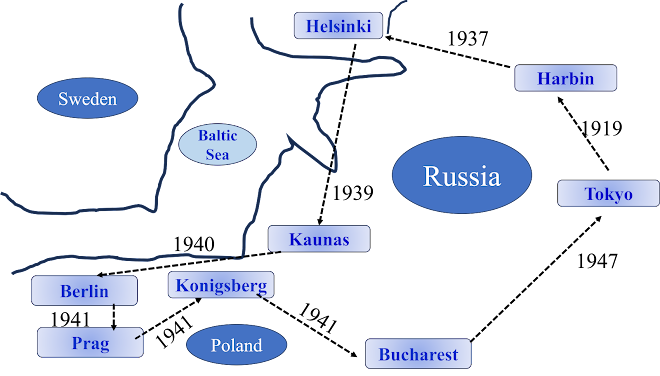Sugihara Chiune: A Japanese Holocaust Rescuer
Fig.
Sugihara Chiune
This is a schematic picture. The innterested reader can visit the following wikipedia site for real image:
https://upload.wikimedia.org/wikipedia/commons/e/e8/Sugihara_b.jpg
In the 1980’s I often went to America to attend technical conferences. In one of those occasions, my flight to Tokyo was the next day after the conference was over. In order to kill my time, I went to a nearby little library where I saw a book with title “The Sugihara Story”. Since then this name never left my head.
Diplomatic Path and Humanitarian Compassion
The Miracle of Visas
In defiance of official instructions from Tokyo, Sugihara took it upon himself to issue 2139 transit visas [2] -[5] to Jewish refugees, allowing them to travel through Japan to safe places. Since each visa was valid for its family members, it is estimated that 6000 people were saved. Sugihara's audacious decision to go against protocol and offer aid to the persecuted was not merely an act of defiance; it was a courageous stand against injustice.
Fig. Visa Sugihara Issued. This is a schematic picture. Interested reader can visit the following for the real image at wikimedia:
https://commons.wikimedia.org/wiki/File:Transit_visa.jpg
Day and night, Sugihara tirelessly wrote visas, driven by his conviction that helping those in need was a responsibility he could not shirk. His right hand started aching such that his wife had give him a massage [6]. He didn't eat lunch and his face started sinking. Despite the imminent threat of consequences from the Nazis, Soviet threat and Japanese authorities, Sugihara chose humanity over bureaucracy.
He had several outstanding capabilities to solve complex problems in a short period of time. I will describe them in my other blogposts.
Legacy of Selflessness
Sugihara's
actions were not solely rooted in empathy but also in a deep moral clarity. He
once said, "I did nothing special. I did what is right." This
sentiment encapsulates his humility and his belief in the fundamental duty of
every human being to stand up for the vulnerable, regardless of the personal
cost.
After the war, he was forced to retire. In 1985, however, Sugihara was recognized as Righteous Among the Nations by Yad Vashem, the World Holocaust Remembrance Center. This title is bestowed upon non-Jewish individuals who risked their lives to save Jews during the Holocaust. Sugihara's selfless actions echoed the deeds of Oskar Schindler and Raoul Wallenberg, reminding the world that even in times of darkness, there are individuals who shine as beacons of hope.
Conclusion
Sugihara's story transcends national
borders, cultures, and languages. He was not just a diplomat; he was a
humanitarian who acted with extraordinary ability to solve complex problems and
courage to alleviate human suffering. His legacy serves as a timeless reminder
that a single individual, driven by compassion and guided by a sense of
justice, can make an indelible mark on history. It would be difficult to find
an incident in the human history where a single individual saved 6000 lives. Sugihara's
life teaches us that even when faced with overwhelming challenges, our actions
have the power to change lives, inspire generations, and remind us of the
inherent goodness that exists within humanity. I will explore details of his
achievements in other blog posts.
[1] Youtube site:
https://www.youtube.com/results?search_query=Chiune+Sugihara+Doc.+1
[2] Altman, I., “The Soviet Union and
the Transit of Jewish Refugees, 1939–1941”, in Sugihara Chiune and the Soviet
Union: New Documents, New Perspectives, Slavic-Eurasian Research Center,
Hokkaido University, 2022
[3] Wolff, D.,
“Phoney War, Phoney Peace: Sugihara’s Shifting Eurasian Context”, in Sugihara
Chiune and the Soviet Union: New Documents, New Perspectives, Slavic-Eurasian
Research Center, Hokkaido University, 2022
[4] Ishigo-oka, K., “Sugihara Chiune
and Stalin” , Gogatshu Shobo, Tokyo, 2022.
[5] Watanabe, K., “Ketsudan: Visas for
Life”, Taisho Shuppan, Tokyo, Third Printing, 2001










Comments
Post a Comment